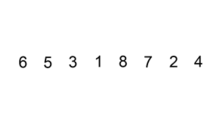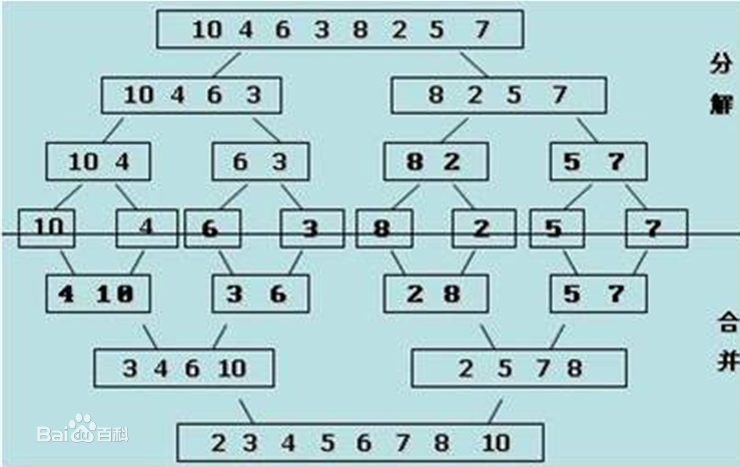经典排序算法【转】
转自 还有多少青春可以挥霍
动画图解 :http://student.zjzk.cn/course_ware/data_structure/web/flashhtml/maopaopaixu.htm (更改后缀拼音)

/* 冒泡排序算法的运作如下: 1.比较相邻的元素。如果第一个比第二个大,就交换他们两个。 2.对每一对相邻元素作同样的工作,从开始第一对到结尾的最后一对。这步做完后,最后的元素会是最大的数。 3.针对所有的元素重复以上的步骤,除了最后一个。 4.持续每次对越来越少的元素重复上面的步骤,直到没有任何一对数字需要比较。 */ public void BubbleSort<T>(T[] needSort) where T : IComparable { T temp; for (int i = 0; i < needSort.Length - 1; i++) { for (int j = i + 1; j < needSort.Length; j++) { if (needSort[i].CompareTo(needSort[j]) > 0) { temp = needSort[i]; needSort[i] = needSort[j]; needSort[j] = temp; } } } }


快速排序采用一种“分而治之、各个击破”的观念。 /* 快速排序使用分治法(Divide and conquer)策略来把一个串行(list)分为两个子串行(sub-lists)。 步骤为: 1.从数列中挑出一个元素,称为 "基准"(pivot), 2.重新排序数列,所有元素比基准值小的摆放在基准前面,所有元素比基准值大的摆在基准的后面(相同的数可以到任一边) 。在这个分区退出之后,该基准就处于数列的中间位置。这个称为分区(partition)操作。 3.递归地(recursive)把小于基准值元素的子数列和大于基准值元素的子数列排序。 递归的最底部情形,是数列的大小是零或一,也就是永远都已经被排序好了。虽然一直递归下去,但是这个算法总会退出,因为在每次的迭代(iteration)中,它至少会把一个元素摆到它最后的位置去。 举个例子 如无序数组[6 2 4 1 5 9] a),先把第一项[6]取出来, 用[6]依次与其余项进行比较, 如果比[6]小就放[6]前边,2 4 1 5都比[6]小,所以全部放到[6]前边 如果比[6]大就放[6]后边,9比[6]大,放到[6]后边,//6出列后大喝一声,比我小的站前边,比我大的站后边,行动吧!霸气十足~ 一趟排完后变成下边这样: 排序前 6 2 4 1 5 9 排序后 5 2 4 1 6 9 b),对前半拉[5 2 4 1]继续进行快速排序 重复步骤a)后变成下边这样: 排序前 5 2 4 1 排序后 1 2 4 5 前半拉排序完成,总的排序也完成: 排序前:[6 2 4 1 5 9] 排序后:[1 2 4 5 6 9] 排序结束 以下代码实现仅供参考 */ public class Code { public void QuickSort<T>(T[] needSort, int low, int high) where T : IComparable { int targetPosition = 0; if (low < high) { targetPosition = PositionArrange(needSort, low, high); QuickSort(needSort, low, targetPosition - 1); QuickSort(needSort, targetPosition + 1, high); } } public int PositionArrange<T>(T[] needSort, int low, int high) where T : IComparable { T tempData = needSort[low]; while (low < high) { while (low < high && needSort[high].CompareTo(tempData) > 0) { high--; } needSort[low] = needSort[high]; while (low < high && needSort[low].CompareTo(tempData) <= 0) { low++; } needSort[high] = needSort[low]; } needSort[low] = tempData; return low; } }


使用插入排序为一列数字进行排序的过程 /* 一般来说,插入排序都采用in-place在数组上实现。具体算法描述如下: 从第一个元素开始,该元素可以认为已经被排序 取出下一个元素,在已经排序的元素序列中从后向前扫描 如果该元素(已排序)大于新元素,将该元素移到下一位置 重复步骤3,直到找到已排序的元素小于或者等于新元素的位置 将新元素插入到该位置后 重复步骤2~5 如果比较操作的代价比交换操作大的话,可以采用二分查找法来减少比较操作的数目。该算法可以认为是插入排序的一个变种,称为二分查找排序。 */ public void InsertSort<T>(T[] needSort) where T : IComparable { for (int i = 1; i < needSort.Length; i++) { T tempData = needSort[i]; int j = i; while (j > 0 && needSort[j - 1].CompareTo(tempData) > 0) { needSort[j] = needSort[j - 1]; j--; } needSort[j] = tempData; //for (int j = 0; j < i; j++) //{ // if (needSort[i].CompareTo(needSort[j]) < 0) // { // T tempData = needSort[i]; // needSort[i] = needSort[j]; // needSort[j] = tempData; // } //} } }


/* 算法描述 归并操作的过程如下: 申请空间,使其大小为两个已经排序串行之和,该空间用来存放合并后的串行 设定两个指针,最初位置分别为两个已经排序串行的起始位置 比较两个指针所指向的元素,选择相对小的元素放入到合并空间,并移动指针到下一位置 重复步骤3直到某一指针到达串行尾 将另一串行剩下的所有元素直接复制到合并串行尾 */ public class CodeSample { public void DataMerge<T>(T[] needSort, int low, int middle, int high, T[] temp) where T : IComparable { Console.WriteLine("low:{0} middle:{1} high:{2}", low, middle, high); foreach (T t in needSort) { Console.Write(t + " "); } Console.WriteLine(); Console.WriteLine("---------------"); int i = low, j = middle; int k = 0; while (i < middle && j < high) { if (needSort[i].CompareTo(needSort[j]) < 0) { temp[k++] = needSort[i++]; } else { temp[k++] = needSort[j++]; } } while (i < middle) { temp[k++] = needSort[i++]; } while (j < high) { temp[k++] = needSort[j++]; } for (int v = 0; v < k; v++) { needSort[low + v] = temp[v]; } } public void MergeSort<T>(T[] needSort, int low, int high, T[] temp) where T : IComparable { if (low + 1 < high) { int middle = (low + high) / 2; MergeSort(needSort, low, middle, temp); MergeSort(needSort, middle, high, temp); DataMerge(needSort, low, middle, high, temp); } } } /* 测试数据:int[] needSort = { 11, 5, 26, 9, 11, 8, 3, 2, 1 }; 输出 low:0 middle:1 high:2 11 5 26 9 11 8 3 2 1 --------------- low:2 middle:3 high:4 5 11 26 9 11 8 3 2 1 --------------- low:0 middle:2 high:4 5 11 9 26 11 8 3 2 1 --------------- low:4 middle:5 high:6 5 9 11 26 11 8 3 2 1 --------------- low:7 middle:8 high:9 5 9 11 26 8 11 3 2 1 --------------- low:6 middle:7 high:9 5 9 11 26 8 11 3 1 2 --------------- low:4 middle:6 high:9 5 9 11 26 8 11 1 2 3 --------------- low:0 middle:4 high:9 5 9 11 26 1 2 3 8 11 --------------- 1 2 3 5 8 9 11 11 26 请按任意键继续. . . */
新增
The Wipphj ,Hello 光



